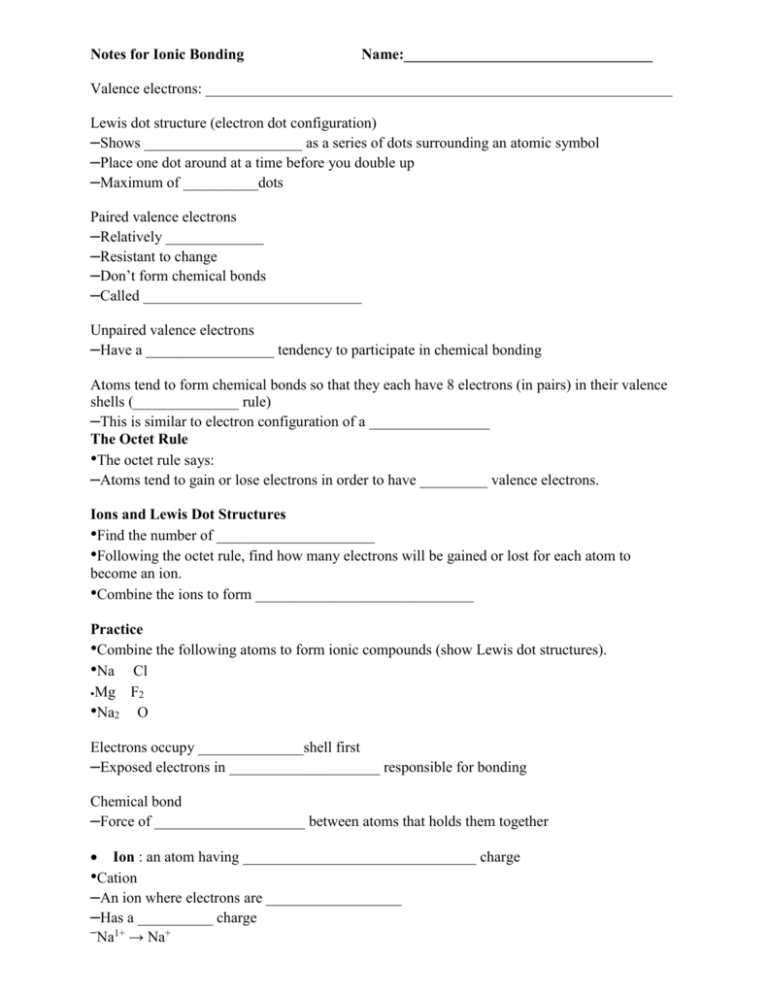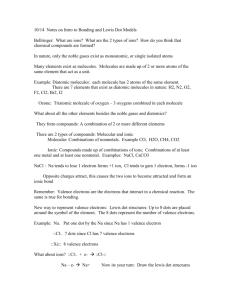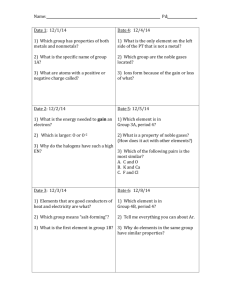Valence electrons - Belle Vernon Area School District
advertisement

Notes for Ionic Bonding Name:_________________________________ Valence electrons: ______________________________________________________________ Lewis dot structure (electron dot configuration) –Shows _____________________ as a series of dots surrounding an atomic symbol –Place one dot around at a time before you double up –Maximum of __________dots Paired valence electrons –Relatively _____________ –Resistant to change –Don’t form chemical bonds –Called _____________________________ Unpaired valence electrons –Have a _________________ tendency to participate in chemical bonding Atoms tend to form chemical bonds so that they each have 8 electrons (in pairs) in their valence shells (______________ rule) –This is similar to electron configuration of a ________________ The Octet Rule •The octet rule says: –Atoms tend to gain or lose electrons in order to have _________ valence electrons. Ions and Lewis Dot Structures •Find the number of _____________________ •Following the octet rule, find how many electrons will be gained or lost for each atom to become an ion. •Combine the ions to form _____________________________ Practice •Combine the following atoms to form ionic compounds (show Lewis dot structures). •Na Cl •Mg F2 •Na2 O Electrons occupy ______________shell first –Exposed electrons in ____________________ responsible for bonding Chemical bond –Force of ____________________ between atoms that holds them together Ion : an atom having _______________________________ charge •Cation –An ion where electrons are __________________ –Has a __________ charge – Na1+ → Na+ •Electron dots for cations –Metals will have __________ valence electrons –These will come off –Forming ________________ ions •Anion –An ion where electrons are ________________ –Ion has an overall ______________ charge –Cl1- → Cl- •Electron dots for anions –Non-metals will have _____________ valence electrons –They will ___________ electrons to fill outer shell –Forming __________________ ions •Ionization Energy –The amount of energy needed to ___________ an electron from an atom –The closer the electron is to the _________________, the harder it is to remove •Ionic bond •Transfer of electrons •Formation of cations and anions •__________________________ hold ions together •Ionic compounds –Are highly __________________ compounds •each anion actually attracts several ________________ •These attract several more anions •A network of ions forms _____________________ •Ionic compounds •Consist of elements found on ________________ sides of the periodic table •Positive and negative charges must _________________ (Oxidation numbers) •When melted or ______________________, they carry an electrical charge Criss-cross method • Examples: • Mg Cl • Na S • Al Br • Ca N • Ba P





